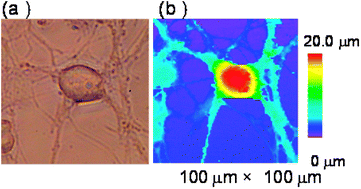Topographic imaging of convoluted surface of live cells by scanning ion conductance microscopy in a standing approach mode
Abstract

- This article is part of the themed collection: Bioelectrochemistry
* Corresponding authors
a
Graduate School of Environmental Studies, Tohoku University, Aramaki Aoba 6-6-11-605, Sendai 980-8579
E-mail:
matsue@bioinfo.che.tohoku.ac.jp
b Hokuto Denko Corporation, 3028 Uenohara, Kamiechi, Atsugi, Kanagawa 243-0801, Japan
c Graduate School of Material Science, University of Hyogo, 3-2-1 Kouto, Kamigori-cho, Ako-gun, Hyogo 678-1297, Japan
d Graduate School of Biomedical Engineering, Tohoku University, Sendai 980

 Please wait while we load your content...
Something went wrong. Try again?
Please wait while we load your content...
Something went wrong. Try again?
Y. Takahashi, Y. Murakami, K. Nagamine, H. Shiku, S. Aoyagi, T. Yasukawa, M. Kanzaki and T. Matsue, Phys. Chem. Chem. Phys., 2010, 12, 10012 DOI: 10.1039/C002607G
To request permission to reproduce material from this article, please go to the Copyright Clearance Center request page.
If you are an author contributing to an RSC publication, you do not need to request permission provided correct acknowledgement is given.
If you are the author of this article, you do not need to request permission to reproduce figures and diagrams provided correct acknowledgement is given. If you want to reproduce the whole article in a third-party publication (excluding your thesis/dissertation for which permission is not required) please go to the Copyright Clearance Center request page.
Read more about how to correctly acknowledge RSC content.
 Fetching data from CrossRef.
Fetching data from CrossRef.
This may take some time to load.
Loading related content
